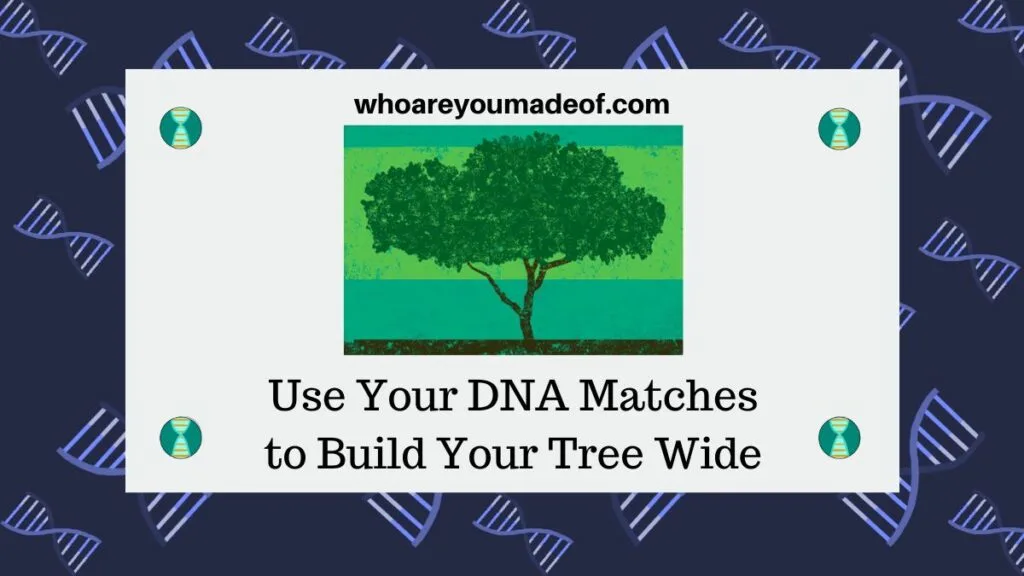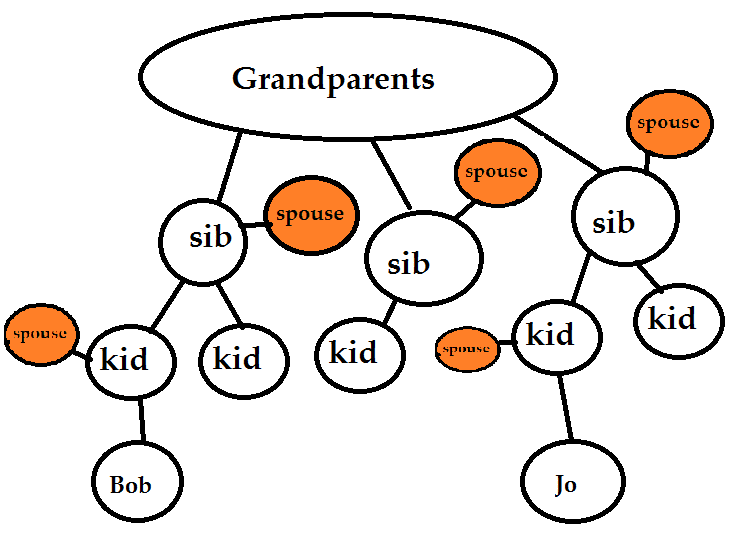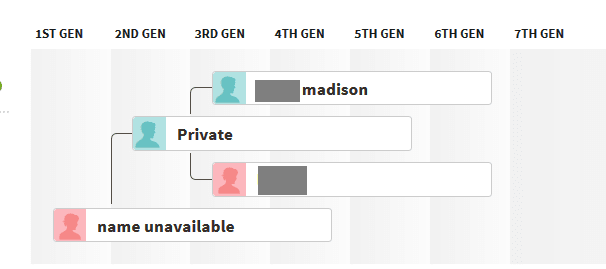Building a wide family tree will help you understand how your DNA matches are related, and learn more about your ancestors. In this post, I’ll teach you how to use your DNA matches to build your tree wide.

I have a confession to make: I used to be a name collector. When it came to family tree research, I only researched my DNA matches to see if I could get one more generation back in my family tree.
I was always looking for the parents of my ancestors – never the siblings. On the rare occasion that I added a sibling of an ancestor to my tree, I almost never bothered to find out who they married, or the names of their children, grandchildren, or great-grandchildren.
A name collector is someone who is only concerned with knowing the names of their ancestors, and generally doesn’t spend much time researching their ancestors’ lives. They are fed by the thrill of the hunt, just wanting to get back one more generation in their tree.
DNA matches make building a family tree extra fun. Name collectors don’t build their trees wide. This was me before I realized that I had been missing out.
As it turns out, building my family tree “wide” has been the most effective tool for researching my family tree, and has even helped me research further back in lines that I had been struggling with.
Building a tree wide is basically building a complete family tree
When I say that it is best to build a “wide” family tree, what I mean is that you should add everyone to it, even those people who are alive, and even those people who are second, third, and fourth cousins to you.
These cousins are descended from the siblings of our ancestors. Technically speaking, they are related to us through collateral lines of our family tree.
Most people don’t grow up knowing who most of these cousins are. In fact, many people don’t know all of their first cousins, much less their second cousins. However, these relatives and their ancestors should always be added to our family tree.
We should add cousins to our family tree, even when they are more distantly related, as soon as they are discovered.
Some people add spouses of their cousins, and even their in-laws. Of course, you can add their children, too, if you know their names.
Each time you click on a DNA match and spot how you are related, you have a chance to add them to your family tree. DNA testing comes in handy to help us locate branches of our family that we have lost touch with, or just never would have known about without having taken a test.
Pro tip: Using this method is also a very efficient and effective way of keeping track of your DNA matches and figuring out how you are related to other matches. Adding them to your family tree, and to your notebook or spreadsheet, will ensure that you don’t spend time on a match that you have already researched.
Adding them to your tree will also help you spot surnames in your family that you didn’t know about, and will help you research other matches from those lines of your family more quickly.
To build your tree wide, start with your top DNA match
If you want to get started building your tree wide, I recommend starting with your top DNA match who is not already in your tree. The goal is to determine how you are related.
You’ll need to know who your common ancestor is so that way you can add their direct ancestor as a sibling to your direct ancestor.
For example, let’s say that I want to add my second cousin to my tree. Second cousins share great-grandparents.
I am descended from my grandmother, and my second cousin is descended from my grandmother’s brother. In order to add my second cousin to my tree, I will have to make sure that my grandmother’s brother and his son (my second cousin’s father) are both added to my tree.
This way, I can add my second cousin to my tree. Hopefully, I have taken the time along the way to add the other siblings of my grandmother, their children, and maybe even all of their grandchildren.
The relationship between second cousins is illustrated below in my primitive sketch. Bob and Jo are second cousins. Hopefully, the person with Bob and Jo in their tree adds all of the “kids”, the spouses and the “sibs” to their tree to build it wide:

You might not have access to all of the information about your match’s ancestors
You might have a DNA match who has wisely taken precautions to protect the privacy of their living relatives, and so you might not know the exact name of their parents, or grandparents. For example, take a look at the screenshot below.
If my match’s name is Vanessa, I can assume that her maiden name is Madison, even though I don’t know the first name of her father:

In the case of my match named Vanessa Madison (name changed for privacy), I will add a “placeholder” father to my tree with no first name and the surname Madison. If I really want to, I might do a Google search looking for obituaries for Vanessa’s Madison grandparents, especially if I know where they lived and/or may have died.
If I am lucky, I might be able to determine the name of Vanessa’s father, and maybe even the names of his siblings. Each person that I add to my tree will save me time later.
For example, if I see a DNA match with the surname of “Madison” later on in the future, this person might be related to me through Vanessa’s Madison ancestor. By adding collateral lines of other relatives descended from my ancestors’ siblings, I will save myself a ton of time in the future.
Of course, I will always respect and protect the privacy of every living person in my tree by marking them as private or”living”, and never posting their information in a non-protected public tree.
How detailed should you get when you are building your tree wide?
You might be wondering if you should be collecting as much information on your living relatives as you probably will on your deceased ancestors and relatives. I feel like adding more than just basic names, dates, geographic locations, and occupations on my living relatives is kind of creepy.
So I don’t do it. I always feel weird if I find myself in someone else’s tree, and I don’t want to make other people feel weird. That’s my rule of thumb.
Unfortunately, I have found myself and my children listed in other people’s family tree – often times with incorrect information associated. Some people use social media to try to glean as much information as they can in order to add living people to their family trees, but I do not recommend doing this.
Perhaps the reason that they want to do this is to save the future generations time in their genealogy research. I don’t think this is necessary.
First, the information that we can collect on living people that are not our direct DNA matches is limited and often incorrect. Second, if we exclude living people from our tree but include all of their ancestors going back to our most recent common ancestor, we are leaving a legacy of a thoroughly-researched and correct family tree that our descendants can use as a starting point.
We need to leave some of the fun for others to have later on.
Go through each DNA match and determine how you are related
We have thousands of DNA matches, especially at the distant cousin level. If you’ve got an infinite amount of time and the inclination, you can do all of your matches.
I’m going to bet that you would like a more manageable number to work with, however, so I will recommend that most people set a goal to personally inspect any DNA match at a 4th cousin level or closer.
If you do this, you’ll have a very wide tree, and will be surprised at what you will learn.
How does adding a DNA match to your tree help you figure out how you are related to someone else?
I’ve been spending a lot of time lately researching my Eastern European (Polish and Slovak) DNA matches. Each time I find a new match, no matter how distant they are, I try to add them to my tree.
Recently, I found a third cousin match who only knew the last name of his great-grandmother, and not his great-grandfather. I instantly recognized the name of his great-great grandmother, since the son of the sister of my great-great grandfather married a woman by this name.
I was happy to add this new third cousin match, along with his father and siblings to my tree. If I see another match with this surname, I don’t have to spend much time searching. I already know a lot this family and I won’t have to wonder if it is the same family or not.
Conclusion
I hope that this post helped you realize the benefits of building your tree “wide” and tall, and gave you some insight into how you can use your DNA matches to do it. If you have any questions or would like to share your experience or thoughts, I would love to hear from you in the comments.
Thanks for stopping by!


Marlene S Anthony
Sunday 20th of December 2020
After reading this, I guess I need to add children and who they married and their children...I thought I was only to put direct line on my tree. Also I made a couple of mistakes on entering names on my tree and it looks like they were their own parents and I don't know how to delete this. I had already put them on and didn't realize this.
Mercedes
Monday 21st of December 2020
Hi Marlene, I'm so glad that this post gave you some ideas about people to add to your tree. If you have assigned people incorrect relationships, you can just edit their relationships to others without having to delete them (and then having to add them back). Once you edit the relationships, the tree should show the correct parents. This post might help you: https://support.ancestry.com/s/article/Fixing-Relationships-in-Trees Good luck!! Mercedes